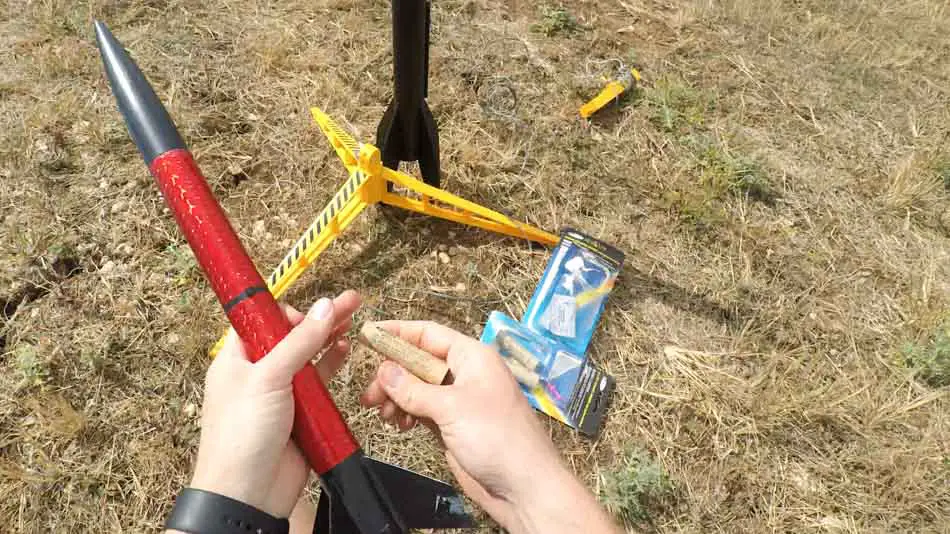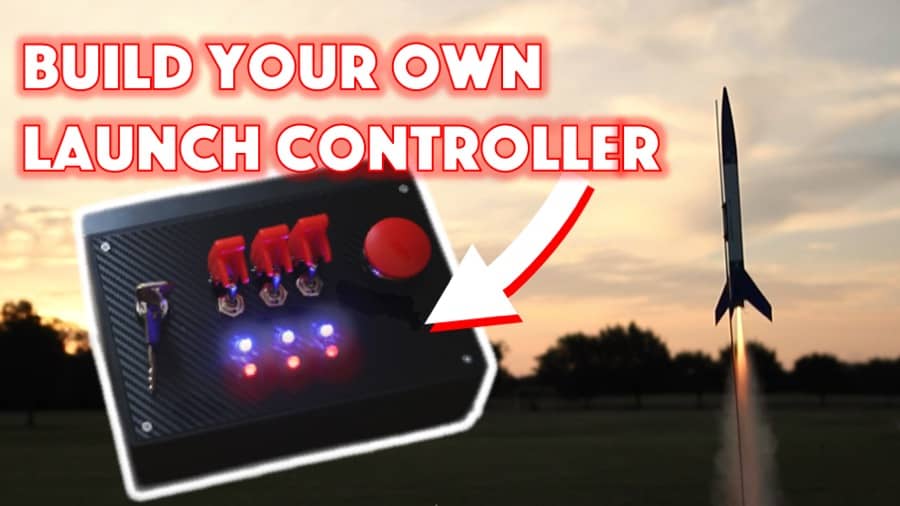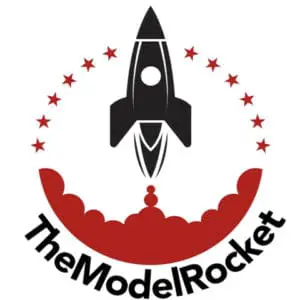
As I watched some Estes rockets soaring through the air at a family party recently, I found myself in awe of the altitudes they were reaching. After becoming curious about the topic, I decided to complete some of my own research in order to find out which of these rockets is the highest flying.
What is the highest flying Estes Rocket/Kit? The highest flying Estes rockets are the E2X Majestic and the E2X Ascender which can both reach an altitude of 3,000 feet when a booster is used. The highest-flying Estes rocket that does not employ a booster is the Yankee, which has a projected max altitude of 1,800 feet.
Continue reading to find out all about the highest flying rockets Estes has to offer and how to select the best engine to reach the highest possible altitude.
Are you still using the standard Estes controllers for your launches?
We just built our own beautiful launch controllers that make launches SO much more fun, and we documented EVERY single step and item purchased and put it into a step-by-step course that teaches you how to do the exact same thing.
Click here to learn more about how you can build your own launch controllers!

The Highest Flying Estes Model Rockets
If you’re looking for a model rocket, Estes will definitely have something to suit your needs. Estes rockets come in a variety of different skill levels and with a variety of different purposes. There is even one that allows you to test how high you can launch the rocket before an egg cushioned in its nose breaks.
One of the most important areas that Estes model rockets vary is how high they can fly. Some rockets will only reach a couple hundred feet while others will go thousands of feet into the air. Less height isn’t necessarily a bad thing.
The higher a model rocket flies, the more difficult it can be to see and to recover. If you’re conducting experiments on model rockets or using them in a classroom setting, a lower flying model might serve your purposes better.
With such a wide variety of unique rocket models, it can be hard to pick just one, but if you want to reach the highest altitude, you’re going to want to go with the Yankee or the E2X Majestic.
The Yankee
The Yankee (link to read reviews on Amazon) is a patriotic rocket with red, white, and blue details. It is an intermediate level rocket meant for children ages 10 and up or with adult supervision and is fairly easy to launch.
The Yankee is 11 inches tall with a 19 mm diameter, and on its own it weighs .4 oz. Its lightweight is one of the reasons it can fly so high.
It is trim with a one piece body tube, wood fins, a conical nose, a bright orange recovery streamer, and self stick decals for decorative purposes.
Estes recommends that you use an A8-3 engine on its first flight. This is a safety precaution.
In the unlikely event that something goes wrong, or you set up the unfamiliar rocket incorrectly, you will be using a less powerful engine, and it wouldn’t cause the same amount of damage that a more powerful engine would.
A lower powered engine will help prevent damage to the rocket or injury to bystanders if this were to happen.
After the first flight, you may want to increase the engine power to see how high and fast you can get the rocket moving. The other recommended engines (in order of smallest to largest) are A8-5, B4-4, B6-4, C6-5, and C6-7. The higher the letter, the more powerful to engine.
Note that if you purchase the rocket it usually comes with just the rocket itself. You will also need a launch system (link to read reviews on Amazon — this is the one I recommend that comes with the actual stand and then the battery powered launch box), model rocket engines (linked above), starters (generally come in the same package as the engines) and recovery wadding if you want to launch it.
E2X Majestic
The E2X Majestic (link to read reviews on Amazon) is not a child’s rocket. It is recommended for model rocket enthusiasts over 18 years of age or with adult supervision, but if you’re just getting into professional model rocket launching, it could be the rocket for you.
It is larger than the Yankee with a 2 inch diameter and a 35.3 inch length, and it weighs 9.7 oz. It is dark purple and silver with plastic fins, self-stick decals, a screw on engine retainer, and an 18 inch nylon parachute recovery.
The F15-6 engine is recommended for the first flight, but after that you can try the F15-8 (it is slightly bigger).
The Majestic achieves a maximum height of 3,000 feet by using the Pro Series II E2X Booster. The booster allows a second engine to be inserted into the rocket. The second engine will take over when the first one burns out allowing your rocket to travel even further.
Without the booster, its maximum projected height of the E2X Majestic is still an amazing 2,000 feet.
You will still need to purchase a launch pad and ignition system. If you want to reach maximum altitude you’ll also need to purchase the E2X Booster so that the rocket will have two separate stages of engines.
E2X Ascender
Alternatively, you could use the E2X Ascender (link to read reviews on Amazon). It can reach the same altitudes of the E2X Majestic, but it is a little longer and heavier. Which rocket you choose is really a matter of person preference and style.
The Ascender’s barrel has a 2 inch diameter, and the rocket stands 42.1 inches tall. It weighs 11 ounces, which is fairly heavy as far as high flying model rockets go. The standard colors are red, white, and black.
The Ascender is constructed with the same materials as the E2X majestic and uses the same launch equipment and the same booster to gain a higher altitude.
Beyond the coloring, size, and shape of the wings, these rockets are nearly identical. They even use the same engines.
For Beginners: Zombie Launch Set
If you’re looking for a beginner level rocket that comes with a launch system, this set will be perfect for you. The Zombie can reach altitudes up to 1,100 feet which is the highest altitude any of the beginner level kits can reach.
It may not be nearly as high as the majestic or the E2X Majestic, but for a starter rocket, it is pretty impressive.
The Zombie Launch Set (link to read reviews on Amazon) includes the Zombie rocket as well as the electron Beam Launch Controller and Porta-Pad II Launch Pad.
You still need to buy engines, starters (which usually come with the engines), recovery wadding, and 4 AA alkaline batteries to power the ignition system, but this is true of any of the model rocket kits available on the Estes website except for the Ready to Fly Saturn V Starter Set, which only reaches an altitude of 200 feet.
The Zombie is 19 inches long with a slim diameter of .98 inches, and it is light weight at 1.7 ounces. The barrel comes already decorated with a zombie themed design, and assembly is minimal to get you blasting off in no time.
It is recommended that the first launch be done with an A8-3 engine, but after that, you can move on to more powerful engines like the A8-5, B4-4, B6-4, C6-5, and C6-7. For safety reasons, only use the recommended engines (nothing bigger or smaller) described in the instructions that come with the rocket.
For Beginners: Journey Launch Set
If zombies aren’t your thing, you could also try the Journey Launch Set (link to read reviews on Amazon) which can also reach 1,100 feet in altitude.
The design of the journey rocket is almost exactly the same with minor differences in weight and shape of the fins. The biggest difference is that it doesn’t have a zombie theme. Instead it is mostly black with red details. The look is sleek and sophisticated.
How to Select an Engine that Gives the Most Altitude
The model rocket you select is only part of the picture when you’re trying to reach a high altitude. The engine you choose to launch your model rocket is the other piece of the puzzle. The engine will directly impact the altitude that your model rocket reaches.
To reach the highest altitudes, you don’t necessarily need the fastest speeds. A lot more goes into maximum altitude than speed.
According to the National Association of Rocketry, the best option if you’re looking to reach the highest possible altitude is to choose a engine with the smallest diameter that has the highest total impulse, the lowest average thrust, and the longer time delay.
I’ll repeat that:
- Small diameter engine
- High total impulse
- Low average thrust
- Long time delay
To put that a different way, you want an engine that is small because it will be lighter. At the same time, you want the engine to have a lot of fuel so that it doesn’t run out too quickly.
A low average thrust will also ensure that the engine provides power for a longer duration, instead of a short burst of power that fizzles out quickly.
The long time delay is suggested so that the rocket will end its coasting phase completely before the recovery system is activated. If the recovery system activated before the rocket stopped gaining altitude, its path would be cut short, and you would not get the most height.
Let’s use the Yankee as an example. The recommended engines for the Yankee are the A8-5, B4-4, B6-4, B6-6, C6-5, and C6-7. These are all standard 18mm engines. The letter tells you the total impulse. The higher the letter, the greater the total impulse. So, in this case, you would want a C engine.
The number next to the letter tells you the average thrust, which is basically how quickly the engine burns through its power. These are both C6’s but if one was a lower average thrust, you’d want to go with that.
Lastly and just as importantly as the other factors, you will look at the time delay, which is the last number in the engine code. The C6-7 waits a whole 2 seconds longer before it activates the recovery system compared to the C6-5. This ensures that the rocket as actually reached its peak, or apogee, before the recovery system activates.
Wind
If you want the best chances of your rocket reaching it maximum altitude, then you will need to launch it in optimal weather conditions. No rain and very little wind.
The National Association of Rocketry warns against launching a rocket when the wind speeds are higher than 20 mph, but this recommendation is about safety, not optimal flight.
Many people don’t want to risk their rocket by flying it in winds speeds higher than 10 mph.
The less windy the day is, the straighter and faster it will fly. If you want to reach maximum altitude, check the expected wind speeds for the day before launching.
Build Your Own Launch Controller
Don’t forget! You can ditch the stock controllers and confidently build your own from scratch using our step-by-step instructions and exact materials list! We promise this will make your launch experience 10x better, and using our course License to Launch you can be 100% confident you’ll be able to finish this project and be super proud of what you’ve built! Here’s a sneak peek below.
